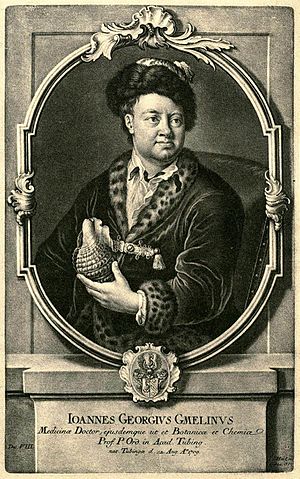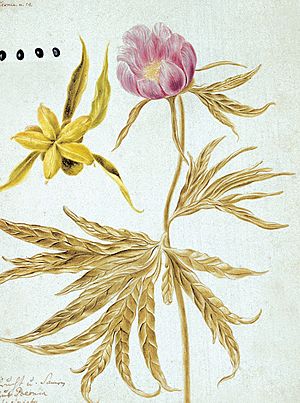Johann Georg Gmelin facts for kids
Quick facts for kids
Johann Georg Gmelin
|
|
|---|---|
 |
|
| Born | 8 August 1709 |
| Died | 20 May 1755 (aged 45) Tübingen,Duchy of Württemberg Holy Roman Empire
|
| Other names | Ioanne Georgio Gmelin, Иоганн Георг Гмелин |
| Education | University of Tübingen |
| Occupation | Physicist and botanist |
| Known for | Exploring Siberia |
| Relatives | Samuel Gottlieb Gmelin (nephew) |
| Scientific career | |
| Institutions | Russian Academy of Sciences, University of St. Petersburg, University of Tübingen |
| Influenced | Johann Amman |
| Author abbrev. (botany) | J.G.Gmel. |
Johann Georg Gmelin was a German scientist who lived from 1709 to 1755. He was a naturalist, which means he studied nature, and also a botanist, someone who studies plants. He was also a geographer, studying the Earth's features. Gmelin is best known for his amazing journeys exploring the vast lands of Siberia and for writing important books about the plants he found there.
Early Life and Learning
Johann Georg Gmelin was born on August 8, 1709, in Tübingen, a city in what is now Germany. His father was a professor at the University of Tübingen, so young Johann grew up surrounded by learning.
Gmelin was a very smart kid. He started going to university classes when he was only 14 years old! By the time he was 18, in 1727, he had already earned a degree in medicine.
After finishing his studies, Gmelin traveled to St Petersburg in Russia. There, he joined the Russian Academy of Sciences in 1728. He started teaching at the university in 1730. The next year, he became a professor of chemistry and natural history, which covers the study of nature.
Exploring Siberia
One of Gmelin's biggest adventures began in 1733 when he joined the Second Kamchatka Expedition. This was a huge journey led by Vitus Bering to explore and map the eastern parts of Siberia and the Pacific Ocean. Gmelin was one of three professors chosen for this important scientific trip.
He left St Petersburg in August 1733 and traveled through the Ural mountains and western Siberia. He even had a young student named Stepan Krasheninnikov with him for part of the journey.
Gmelin made many important discoveries during this expedition:
- He described the Yenisey river as the border between Europe and Asia.
- He helped measure the lowest temperature ever recorded at Yeniseysk at that time.
- He was the first person to figure out that the Caspian Sea was actually lower than the Mediterranean Sea.

In September 1736, Gmelin finally reached Bering’s main camp in Yakutsk. But then, something terrible happened. On November 8, his home burned down! This fire destroyed all his collections of plants and animals, his notes, and even some of his books.
The next summer, Gmelin worked hard to collect as many new specimens as he could to replace what he had lost. His most famous work, Flora Sibirica (which means "Plants of Siberia"), was based on all his observations and collections from this journey. This book, published between 1747 and 1769, describes 1178 different plant species. He even drew pictures of 294 of them! His nephew, Samuel Gottlieb Gmelin, helped him finish the last two volumes.
Gmelin also wrote a book about his travels called Reise durch Sibirien von dem Jahr 1733 bis 1743 (meaning "Journey through Siberia from the Year 1733 to 1743"). This book shared all the amazing things he saw and learned during his long expedition.
Later Life and Legacy
After his incredible journey through Siberia, Gmelin returned to the University of Tübingen in 1747. He became a professor of medicine again. In 1751, he became the director of the university's botanic garden, a place where many different kinds of plants are grown for study.
His travel book was published in Tübingen and was translated into French and Dutch.
In 1749, Gmelin was chosen as a foreign member of the Royal Swedish Academy of Sciences, a very respected group of scientists.
Many plants and animals have been named after him to honor his contributions to science. For example, a plant genus called Gmelina is named after him.
Gmelin passed away on May 20, 1755, in Tübingen. His work helped us understand much more about the natural world, especially the plants and geography of Siberia.
See also
 In Spanish: Johann Georg Gmelin para niños
In Spanish: Johann Georg Gmelin para niños

